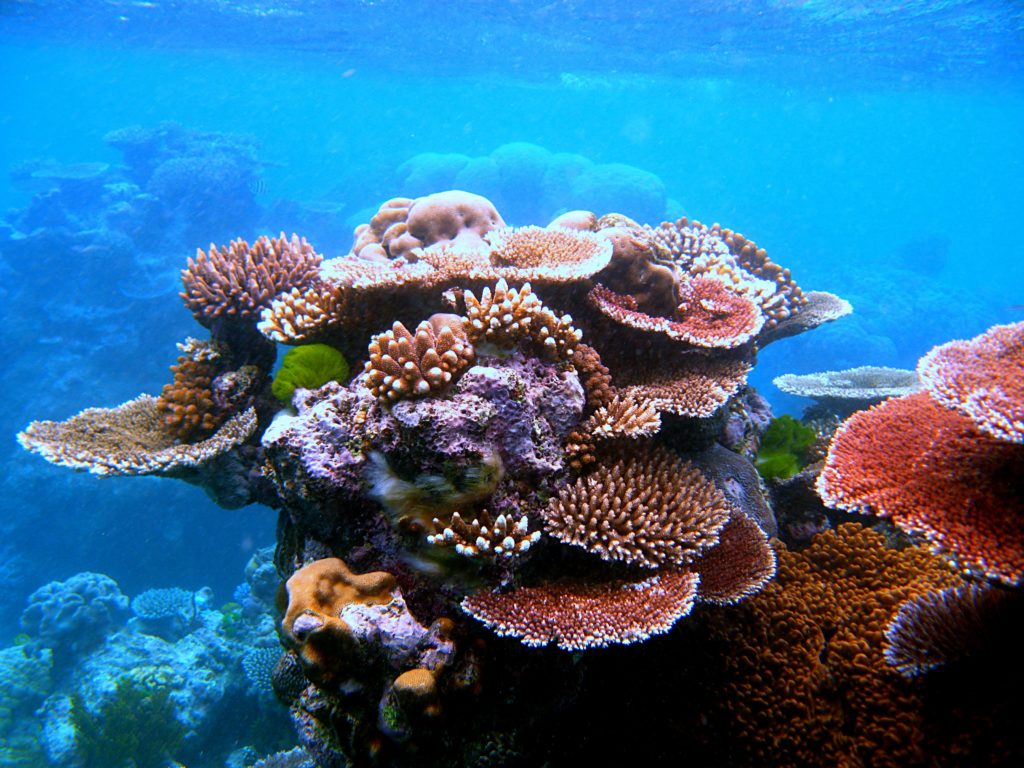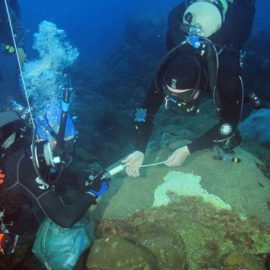
!00 degree water and corals are suffering.
Inside a low-slung building in the heart of the Florida Keys, Cynthia Lewis is running what she calls a “coral mass triage unit.” As a blistering marine heat wave persists off the coast, a full-blown emergency is unfolding along the only living coral barrier reef in the continental United States. “If it remains this hot for the next six weeks, we are going to see a lot more coral mortality out there,” said Lewis, director of the Florida Institute of Oceanography’s Keys Marine Laboratory. Already, scientists have reported widespread coral bleaching along parts of the roughly 360-mile-long reef, the third largest on the planet. If the heat drags on, they say, a massive coral die-off could follow, with grave consequences for fish and other ocean organisms that depend on the reefs, tourism, commercial fishing and part of the state’s very identity. “This is definitely the worst bleaching event that Florida has ever seen,” said Andrew Baker, who directs the Coral Reef Futures Lab at the University of Miami. “We knew something like this was going to happen at some point, we just didn’t know when. We still managed to be surprised by the magnitude of this event and how early it came in the season.”
washingtonpost.com
Corals can take warm water but not for long.
In a summer that has scorched both land and sea, the precarious future of Florida’s corals offers the latest example of what stands to be irretrievably lost as the world grows ever hotter. Corals can survive high water temperatures, but not for long periods of time, making the arrival of excessive heat so early in the season such a troubling development. Lewis’s lab, with its temperature-controlled, seawater aquariums, is providing refuge to more than 1,500 coral specimens that have been harvested from offshore nurseries and parent colonies, in hopes that they can be returned to the sea when the water finally cools. Day after day, Lewis has seen researchers emerge from their underwater missions shaken by the magnitude of bleaching that they have seen. “It’s emotionally draining,” she said. Figuring out how to help the corals survive the current predicament is difficult and uncertain work. But also critical, Baker said, because this moment is one that could leave a lasting scar up and down Florida’s coastline. “A bleached coral can recover,” he said, “but a dead coral does not.”
The heat wave came early.
How early the heat wave arrived is what has proven most unsettling to scientists who study and try to preserve Florida’s imperiled corals. The corals have endured past incidents of bleaching, a process in which stressed corals expel their symbiotic algae, known as zooxanthellae, and turn pale or white. The frequency and severity of such events has increased since the 1980s, and one of the last significant bleaching events off the Florida Keys took place in 2014. That summer, according to the National Oceanic and Atmospheric Administration, high water temperatures in the Keys triggered bleaching that damaged or killed a third of elkhorn coral at seven federal monitoring sites in the Upper Keys. But unlike now, that event spanned August into September, when summer was giving way to fall and waters would naturally begin to cool. “This time, we still have the hottest months of summer ahead of us,” Lewis said. “I’ve seen it before, but not this early.” That’s also partly what worries Derek Manzello, an ecologist and head of NOAA’s Coral Reef Watch program. He said the state has experienced eight coral bleaching events since 1987, but typically they haven’t occurred until at least mid-August. This time, water temperatures began to spike earlier this month. “So we are a full month ahead of when we have historically seen heat stress manifest in Florida,” Manzello said. Meanwhile, he added, “The magnitude of the heat stress is literally off the charts.”
Corals like the same temperatures humans like.
Corals comfortably grow in water temperatures between 73 and 84 degrees Fahrenheit, according to NOAA. When water temperatures are too warm, corals push out the algae living in their tissues, triggering a bleaching event. They cannot tolerate high temperatures for long periods. For now, many corals off South Florida are suffering through extraordinary temperatures with no end in sight. On Monday evening, a buoy in Manatee Bay, about 40 miles south of Miami, posted a temperature of 101.1 degrees at 6 p.m. For comparison, the “ideal” temperature of a hot tub is 100 to 102 degrees, according to jacuzzi.com. But that reading was merely one of multiple extreme temperatures in South Florida’s offshore waters. To the southwest, a buoy near Johnson Key topped out at 98.4 degrees. The average of the two dozen observation locations in and around Florida Bay was around 96 degrees during the early evening — even higher than air temperatures. In Key West, ocean temperatures are sitting at 90.5 degrees — well above the monthly average for the area of 87.4 degrees. Water samples off Vaca Key were showing water temperatures at 93.4 degrees as of Tuesday, according to NOAA’s National Data Buoy Center. Underwater, that reality has led to a slow-motion disaster.
The water temperatures are too hot even for the hardiest of the corals.
Ocean temperatures are now so elevated that “it’s likely becoming an existential threat for even the hardiest of corals on Florida’s coral reef,” Phanor Montoya-Maya, a restoration program manager at the Key Largo-based Coral Restoration Foundation, said in an interview. In the Lower Florida Keys, the group said, it has observed “significant coral mortality” at sites including Sombrero Reef, Cheeca Rocks, Horseshoe Reef, Newfound Harbor and Looe Key. It also reported “100 percent bleaching” in the Looe Key Coral Tree Nursery, home to roughly 6,000 corals. “We are seeing extensive coral bleaching and mortality due to these elevated water temperatures,” Montoya-Maya said. “Reefs and nurseries in the Upper Keys are showing early signs of thermal stress, with corals beginning to pale — the first sign of bleaching.” Out of the five levels on NOAA’s alert scale for corals, current conditions are categorized at the most extreme category, known as Alert Level 2. The harrowing conditions are projected to remain for the next 12 weeks, the agency has said. “And the big problem here is, the impacts that a coral experiences are a direct result of how long they are exposed to the stress, and how severe that stress is,” NOAA’s Manzello said. Jesse Senko, a marine conservation biologist and professor at Arizona State University, said that while the El Niño climate pattern that has developed this summer typically fuels hotter ocean temperatures, the current marine heat wave was almost certainly made more severe by climate change. “The worry now is that we’re hitting a tipping point,” Senko said. “Once this becomes the norm and you have multiple summers like this, it could be catastrophic for most of the world’s coral reefs.”
Corals have fallen over the years for other reasons than hot water.
In recent decades, healthy coral cover in the Florida Keys has fallen by more than 90 percent due to a range of stressors, including disease, heat stress and damage from boats and storms. That deterioration, along with the prospect of worsening climate change, has led the federal government, universities and nonprofits to ramp up efforts to protect, salvage and restore the reef. It’s also why the ongoing heat wave is particularly disheartening to scientists who have dedicated their lives to studying and preserving Florida’s corals. “It’s upsetting because you realize what is being lost,” said Baker, of the University of Miami. He likened the situation to a forest fire raging through an old growth forest. As heat stress threatens to destroy corals that have blanketed the ocean floor for thousands of years in some places, so much else would disappear along with them. “The reefs provide the ecosystems that support fishing, diving, tourism, jobs,” Lewis said. “In that respect, the reef is very important to the economy of Florida.” The reefs also provide a first line of defense against storms and hurricanes, buffering powerful waves before they arrive on shore. “An underwater sea wall,” is how Baker, whose work focuses in part on helping corals be more resilient to warming water, describes it. “In Florida, we are very flat, and there’s a tremendous amount of built infrastructure. Reefs are really protecting all that.” For all those reasons, Baker said, “Florida is the coral restoration capital of the world. Or it was.”
The coral labs are busy and there are a number of them
Numerous labs spread throughout the Keys, academic researchers around South Florida and the Tampa Bay region, scientists at the Florida Aquarium and others have spent years working to preserve the corals that remain and undertake creative solutions to help the reef survive in a hotter and more acidic ocean. Government agencies from NOAA to the Defense Department have helped fund such efforts. But amid the current, crippling heat wave, the work of restoration has temporarily taken a back seat to the urgency of trying to protect and salvage what remains. At her lab on Long Key where she has spent more than two decades, Lewis spends these days surrounded by hundreds of threatened coral specimens in her triage unit, where staffers clean the tanks, maintain water temperatures and ensure corals have the food they need. “We are going to save as many corals as we can, so we can maybe build better and stronger corals in the future,” she said, “so that they are more resilient and resistant to the current climate.” She knows that just a few miles away under the water, the situation is dire. But like her colleagues that keep diving beneath the surface, she holds fast to the hope that better days lie ahead. “I refuse to think all is lost.”
Having swum in Florida waters and seen the coral it would be a loss.



